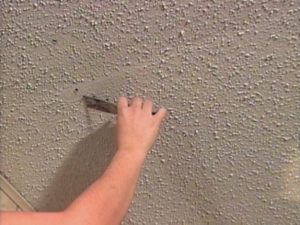How to Fix Popcorn Ceiling
 The smallest crack in a popcorn ceiling can appear huge and give not a charming look for the room. These difficult to repair, hard to clean, and catch dust easily. The three methods to fix the popcorn ceilings, namely skim coat with plaster to create a new texture, cover with a new layer of drywall, or scrape.
The smallest crack in a popcorn ceiling can appear huge and give not a charming look for the room. These difficult to repair, hard to clean, and catch dust easily. The three methods to fix the popcorn ceilings, namely skim coat with plaster to create a new texture, cover with a new layer of drywall, or scrape.
1. Skim coat on a new design
This is basically still related to a texture, it’s fairly easy for homeowners to do themselves. Often found in older homes this method involves cleaning and prepping the existing substrate with quick-set drywall mud, applying a bonding agent like joint compound, and then applying a finishing compound with a trowel or knife to create a new texture.
The reason why this is a great solution is many old-house owners want to recapture the history of the home. Clearly, a smooth ceiling won’t fit the bill. The most important consideration is to make sure the substrate is structurally secure, since adding a wet product could create more weight than the ceiling can handle and cause it to come down. For this consultation with a contractor before getting started might be needed.
An additional tip, if the skim coat is chosen, use a quick-set drywall mud, then touch it up with a ready-mixed joint compound.Don’t use a ready-mixed material as the base, as it has a higher moisture content and contains silica, which is prone to causing some shrinkage, affecting the final ceiling look.
2. Scrape
To execute this use a 4-inch utility knife or a drywall knife to chip away at the texture and create a smooth surface. In addition to that, skimming is probably needed with a thin layer of joint compound to smooth out imperfections, then sand it smooth before repainting.
This method is by far the most common method of popcorn ceiling removal. Scraping the ceiling is a messy and slow process, but it’s the most cost-effective and can be completed by one person. However, it is worth to note that popcorn finishes and paint applied before 1979 often contained asbestos and lead, respectively, which could be toxic if sent airborne. For this reason, need to be put caution. It is recommended to test with the expert. If it tests positive contain asbestos it is better do not scrape it.
If the ceilings are not at risk for asbestos or lead paint, but they have been painted, it may be near impossible to scrape them, since the porous popcorn material will have soaked it up. Drywalling over them may be a better option.
A lot of people spray their ceilings with water before scraping to loosen them up, however, according to the expert not only will it be a sloppy mess, but it will absorb into the ceiling and make it heavy. Then it could start to expand and crack. It’s more time-consuming, and it’s best to scrape it dry.
3. Cover with drywall
To execute this is by affixing ceiling-grade gypsum board, which weighs significantly less than standard wallboard, right over the existing popcorn ceiling. For this screw, it securely into the framing is needed and be proficient at mudding and taping for a seamless job.
This is a better option than scraping if only lead paint or asbestos is available because it can encapsulate the harmful substance instead of sending it airborne. Another plus is getting the smoothest possible finish if it isgiven mude and tape properly. If the ceiling has damage or if it is needed to be cut into it to reroute electrical or HVAC, this is an opportunity to make large cuts into the existing substrate without worrying about patching, since they’ll soon be covered up anyway.
This method will come at a price—a 4-by-8-foot sheet of ceiling-grade gypsum board costs $9 apiece. If this becomes a DIY project, it may also be difficult to maneuver the boards’ singlehandedly. In addition to that, if crown molding is already there, this most likely need to have to remove it and replace it.
Additional tips for this method is renting a drywall lift, particularly if this become a DIY project. This might cost about $34 per day, depends on the location and pricing, however, this is safer and allow to get a better handle on the material.




